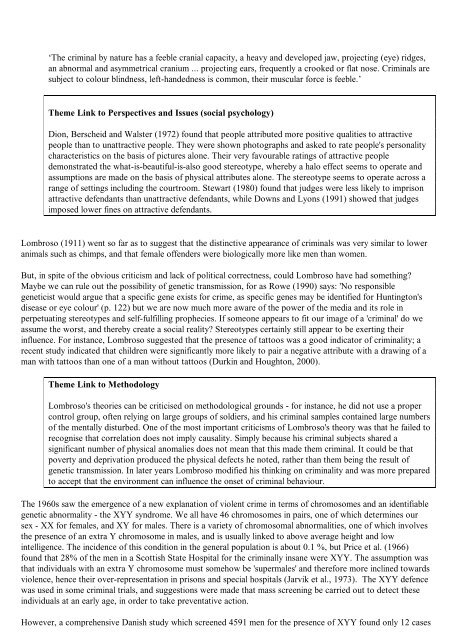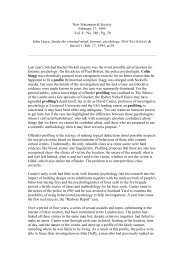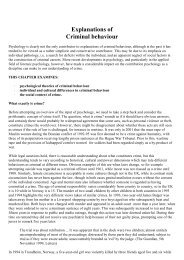Explanations of Criminal behaviour - Jeff Standen
Explanations of Criminal behaviour - Jeff Standen
Explanations of Criminal behaviour - Jeff Standen
You also want an ePaper? Increase the reach of your titles
YUMPU automatically turns print PDFs into web optimized ePapers that Google loves.
‘The criminal by nature has a feeble cranial capacity, a heavy and developed jaw, projecting (eye) ridges,<br />
an abnormal and asymmetrical cranium ... projecting ears, frequently a crooked or flat nose. <strong>Criminal</strong>s are<br />
subject to colour blindness, left-handedness is common, their muscular force is feeble.’<br />
Theme Link to Perspectives and Issues (social psychology)<br />
Dion, Berscheid and Walster (1972) found that people attributed more positive qualities to attractive<br />
people than to unattractive people. They were shown photographs and asked to rate people's personality<br />
characteristics on the basis <strong>of</strong> pictures alone. Their very favourable ratings <strong>of</strong> attractive people<br />
demonstrated the what-is-beautiful-is-also good stereotype, whereby a halo effect seems to operate and<br />
assumptions are made on the basis <strong>of</strong> physical attributes alone. The stereotype seems to operate across a<br />
range <strong>of</strong> settings including the courtroom. Stewart (1980) found that judges were less likely to imprison<br />
attractive defendants than unattractive defendants, while Downs and Lyons (1991) showed that judges<br />
imposed lower fines on attractive defendants.<br />
Lombroso (1911) went so far as to suggest that the distinctive appearance <strong>of</strong> criminals was very similar to lower<br />
animals such as chimps, and that female <strong>of</strong>fenders were biologically more like men than women.<br />
But, in spite <strong>of</strong> the obvious criticism and lack <strong>of</strong> political correctness, could Lombroso have had something?<br />
Maybe we can rule out the possibility <strong>of</strong> genetic transmission, for as Rowe (1990) says: 'No responsible<br />
geneticist would argue that a specific gene exists for crime, as specific genes may be identified for Huntington's<br />
disease or eye colour' (p. 122) but we are now much more aware <strong>of</strong> the power <strong>of</strong> the media and its role in<br />
perpetuating stereotypes and self-fulfilling prophecies. If someone appears to fit our image <strong>of</strong> a 'criminal' do we<br />
assume the worst, and thereby create a social reality? Stereotypes certainly still appear to be exerting their<br />
influence. For instance, Lombroso suggested that the presence <strong>of</strong> tattoos was a good indicator <strong>of</strong> criminality; a<br />
recent study indicated that children were significantly more likely to pair a negative attribute with a drawing <strong>of</strong> a<br />
man with tattoos than one <strong>of</strong> a man without tattoos (Durkin and Houghton, 2000).<br />
Theme Link to Methodology<br />
Lombroso's theories can be criticised on methodological grounds - for instance, he did not use a proper<br />
control group, <strong>of</strong>ten relying on large groups <strong>of</strong> soldiers, and his criminal samples contained large numbers<br />
<strong>of</strong> the mentally disturbed. One <strong>of</strong> the most important criticisms <strong>of</strong> Lombroso's theory was that he failed to<br />
recognise that correlation does not imply causality. Simply because his criminal subjects shared a<br />
significant number <strong>of</strong> physical anomalies does not mean that this made them criminal. It could be that<br />
poverty and deprivation produced the physical defects he noted, rather than them being the result <strong>of</strong><br />
genetic transmission. In later years Lombroso modified his thinking on criminality and was more prepared<br />
to accept that the environment can influence the onset <strong>of</strong> criminal <strong>behaviour</strong>.<br />
The 1960s saw the emergence <strong>of</strong> a new explanation <strong>of</strong> violent crime in terms <strong>of</strong> chromosomes and an identifiable<br />
genetic abnormality - the XYY syndrome. We all have 46 chromosomes in pairs, one <strong>of</strong> which determines our<br />
sex - XX for females, and XY for males. There is a variety <strong>of</strong> chromosomal abnormalities, one <strong>of</strong> which involves<br />
the presence <strong>of</strong> an extra Y chromosome in males, and is usually linked to above average height and low<br />
intelligence. The incidence <strong>of</strong> this condition in the general population is about 0.1 %, but Price et al. (1966)<br />
found that 28% <strong>of</strong> the men in a Scottish State Hospital for the criminally insane were XYY. The assumption was<br />
that individuals with an extra Y chromosome must somehow be 'supermales' and therefore more inclined towards<br />
violence, hence their over-representation in prisons and special hospitals (Jarvik et al., 1973). The XYY defence<br />
was used in some criminal trials, and suggestions were made that mass screening be carried out to detect these<br />
individuals at an early age, in order to take preventative action.<br />
However, a comprehensive Danish study which screened 4591 men for the presence <strong>of</strong> XYY found only 12 cases







